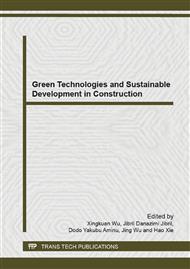[1]
N. Lechner. Heating, Cooling, Lighting: Sustainable Design Methods for Architects, Third Eds., John Wiley & Sons, Inc (2009).
Google Scholar
[2]
A. Zain-Ahmad and K. Sopian and M.Y.H. Othman and Abidin, Z. Zainol, The Availability of Daylight from Tropical Skies: A Case Study of Malaysia, Renewable Energy, Vol. 25, 2002, pp.21-30.
DOI: 10.1016/s0960-1481(00)00209-3
Google Scholar
[3]
Aghemo, C., Pellegrino, A. & Loverso, V.R.M., The Approach to Daylighting by Scale Models and Sun and Sky Simulators: A Case Study for Different Shading Systems. Build Environment, Vol. 43, No. 5, 2008, pp.917-927.
DOI: 10.1016/j.buildenv.2007.01.020
Google Scholar
[4]
Stevens, G, The Reasoning Architect (3rd edition), Sydney: The University of Sydney, (1988).
Google Scholar
[5]
Nik Ibrahim, N.L., Hayman, S. & Hyde, R., A Typological Approach to Daylighting Analysis, 44th Annual Conference of The Architectural Science Association (ANZAScA), Unitec Institute of Technology, (2010).
Google Scholar
[6]
P.R. Boyce, Human Factors in Lighting. London: Applied Science Publishers (1981).
Google Scholar
[7]
C. Day, Spirit and Place. Oxford: Architectural Press (2002).
Google Scholar
[8]
P. Manning, (Ed). Office Design: A Study of Environment. Liverpool: The Pilkington Research Unit & Dept. of Building Science, University of Liverpool (1965).
Google Scholar
[9]
P.F. Smith, Architecture in a Climate of Change (2nd edition). Oxford: Architectural Press/Elsevier (2005).
Google Scholar
[10]
P. Guthrie, The Architect's Portable Handbook: First Step Rules of Thumb for Building Design. New York: Mc-Graw-Hill (1995).
Google Scholar
[11]
E. Allen & J. Lano, The Architect's Studio Companion: Rules of Thumb for Preliminary Design (3rd edition). New York: John Wiley & Sons (2002).
Google Scholar
[12]
Laouadi, A. & Galasiu, A.D., Effective Solar Shading Devices for Residential Windows Save Energy and Improve Thermal Conditions, Lighting Design + Application: LD + A, Vol. 39, No. 6, 2009, pp.18-22.
Google Scholar
[13]
Gutierrez, G.C.R. & Labaki, L.C., An Experimental Study of Shading Devices: Orientation Typology and Material. Thermal Performance of Exterior Envelopes of Whole Buildings X, (2007).
Google Scholar
[14]
Dubois, M.C., Impact of Solar Shading Devices on Daylight Quality: Measurements in Experimental Office Rooms (Research Report), Sweden: Lund University, (2001).
Google Scholar
[15]
Flynn, J.E., Kremers, J.A., Segil, A.W., & Steffy, G.R., Chapter 5: Light Generation and Control. Architectural Interior Systems: Lighting, Acoustics, Air Conditioning (3rd edition), New York: Van Nostrand Reinhold, (1992).
Google Scholar
[16]
Boylan, B., The lighting Primer, Ames: Iowa State University, (1987).
Google Scholar
[17]
Lynes, J.A., Chapter 3: Daylight and Energy. In S. Roaf and M. Hancock (Eds. ), Energy Efficient Building A Design Guide, Oxford: Blackwell Scientific Publications, (1992).
Google Scholar


